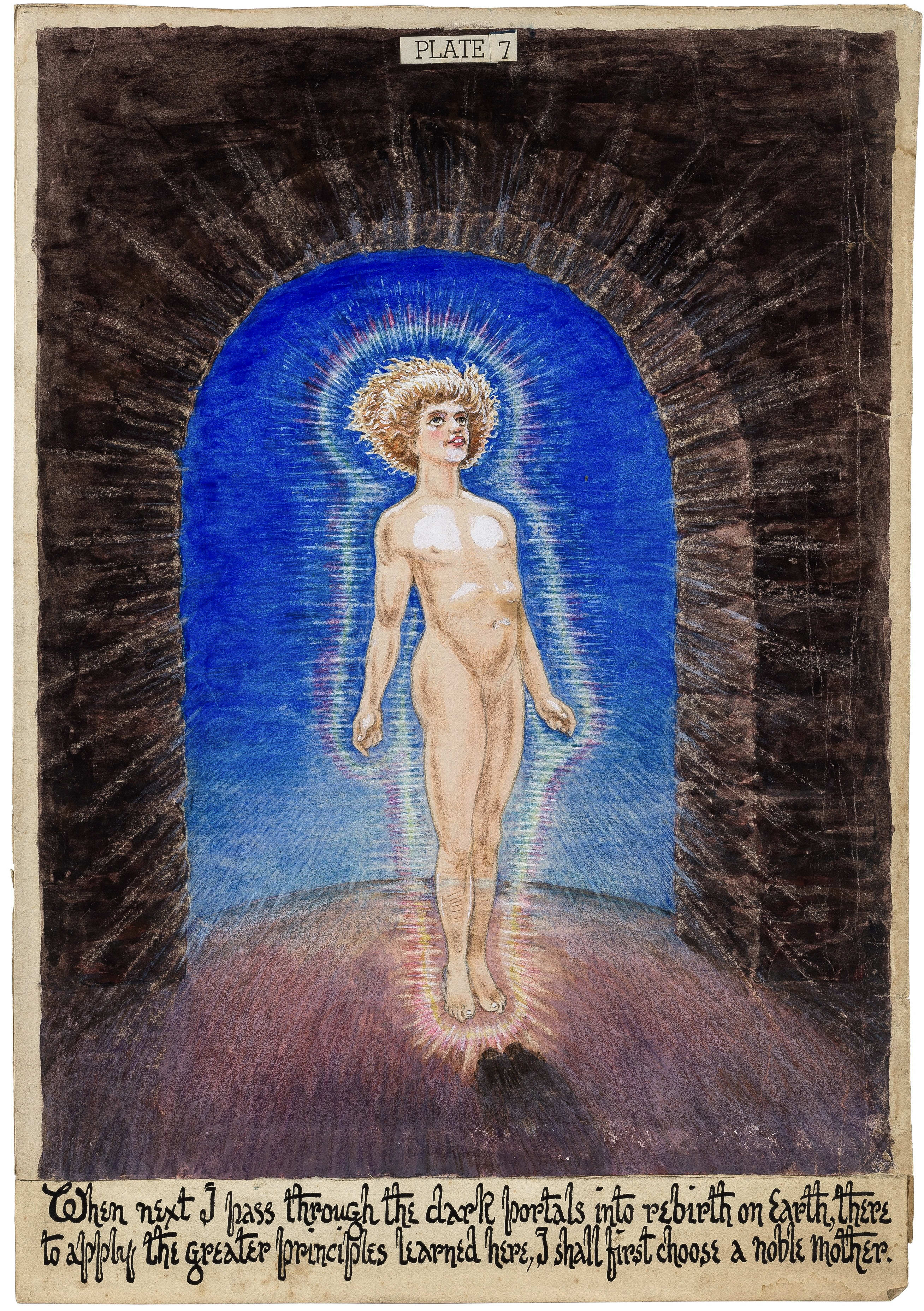 Grant Wallace, Rebirth on Earth, ca. 1919–25, watercolor, gouache, and ink on paper, 18 × 12".
Grant Wallace, Rebirth on Earth, ca. 1919–25, watercolor, gouache, and ink on paper, 18 × 12".
Grant Wallace
The mesmerizing art of Grant Wallace (1868–1954), a phantasmagoric amalgamation of theosophical tract, circus flyer, and beauty advertisement—all of which is shot through with a generous dose of science fiction—defies tidy categorization. Exhibited for the first time, thirty-one of the artist’s drawings, discovered by his great-grandchildren in 2021, were on display at Ricco/Maresca Gallery. The illustrations, executed between 1919 and 1925, were intended for different books Wallace had planned on publishing, one of which he characterized as “an astral album of autographic scripts and self-portraits.” Each page featured delicate renderings of supernatural entities combined with messages the artist mediumistically channeled from them for humanity’s edification. Wallace transcribed his communications via flamboyant calligraphy onto artfully torn pieces of paper that were collaged into each work, like speech bubbles for a psychic comic book. The details were extraordinary: Every missive appeared to have been written in a different hand, their diversity emphasizing Wallace’s assertion that these bulletins were delivered by various entities “over the psychic radio,” to borrow the artist’s phrase, which also happened to serve as the title of this show.
An imaginative cast of characters takes center stage in Wallace’s drawings: from the Greek goddess Artemis and an assortment of ancient Egyptian spirits to various inhabitants from outer space, e.g., Zozomida of the Pleiades (according to the artist, she was the Eve of Atlantis). One such alien, Zuraleo, is portrayed wearing an elegant, tight-fitting space helmet with a delicate chain looping around her neck. With her enormous lashed eyes and bow lips, she resembles a movie-star flapper. Indeed, many of Wallace’s entities are gorgeous Gibson Girl look-alikes who possess flowing manes of hair, regal profiles, and tender all-knowing expressions, like those of saints printed on holy cards. A fetching extraterrestrial whom Wallace described as being FROM [THE] FAR PLANET ZAERRUEZ, demands that we LEARN THIS: THAT RHYTHMIC RAYS OF HUMAN THOUGHT ENMESH A MILLION INHABITED GLOBES—A SENTIENT WEB. In the lower right-hand corner of the drawing in which this figure appears is a series of abstract hieroglyphs, presumably from another interplanetary alphabet. All of Wallace’s works contain a sincere and touching array of admonitions (against such sins as laziness and modern art), inspiring philosophies, and assurances that the afterlife exists. NEVER WAS I SO MUCH ALIVE AS AFTER I DIED, declares one departed soul.
The accompanying exhibition catalogue has a lively essay by Lucy Sante that places Wallace within the historic context of American spirit-seeking during the nineteenth and early twentieth centuries. Sante emphasizes the influence of Theosophy, whose founder, Helena Blavatsky, was a medium who channeled her teachings from the mysterious Tibetan “ascended masters.” This synthesis of diverse religious traditions introduced such ideas as reincarnation and karma to Western audiences. Although born on a farm in Missouri, Wallace ultimately found himself in California. Embracing that state’s pioneering sense of reinvention, he became a journalist while enthusiastically exploring spiritualism in his spare time. In a touching essay written for the catalogue’s introduction, Matt Berger, Wallace’s great-grandson, describes the journeys these extraordinary drawings took over time; at one point, they narrowly missed being destroyed by a California wildfire. Miraculously surviving all manner of perils and shown a century later, Wallace’s marvelous works are a welcome gift to this ravaged world.
